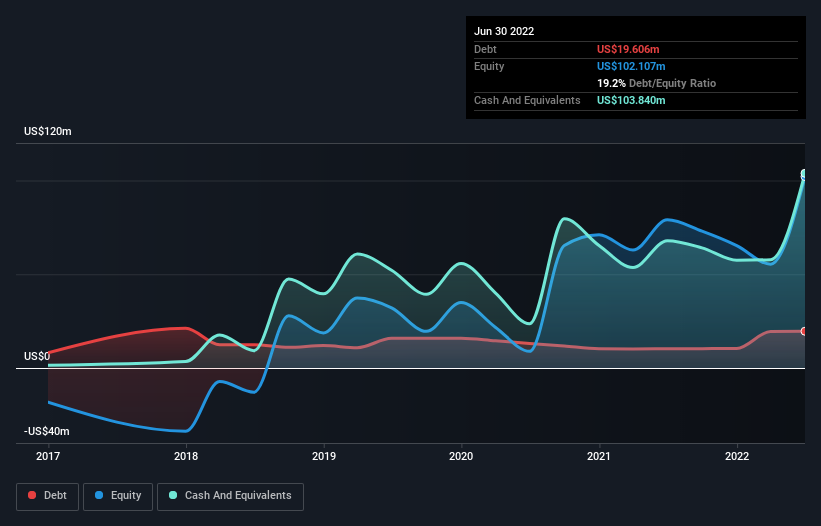- United States
- /
- Pharma
- /
- NasdaqCM:LQDA
Liquidia (NASDAQ:LQDA) May Not Be Profitable But It Seems To Be Managing Its Debt Just Fine, Anyway
David Iben put it well when he said, 'Volatility is not a risk we care about. What we care about is avoiding the permanent loss of capital.' It's only natural to consider a company's balance sheet when you examine how risky it is, since debt is often involved when a business collapses. We can see that Liquidia Corporation (NASDAQ:LQDA) does use debt in its business. But the real question is whether this debt is making the company risky.
What Risk Does Debt Bring?
Debt and other liabilities become risky for a business when it cannot easily fulfill those obligations, either with free cash flow or by raising capital at an attractive price. Part and parcel of capitalism is the process of 'creative destruction' where failed businesses are mercilessly liquidated by their bankers. While that is not too common, we often do see indebted companies permanently diluting shareholders because lenders force them to raise capital at a distressed price. Of course, debt can be an important tool in businesses, particularly capital heavy businesses. When we examine debt levels, we first consider both cash and debt levels, together.
View our latest analysis for Liquidia
How Much Debt Does Liquidia Carry?
You can click the graphic below for the historical numbers, but it shows that as of June 2022 Liquidia had US$19.6m of debt, an increase on US$10.3m, over one year. But it also has US$103.8m in cash to offset that, meaning it has US$84.2m net cash.

How Strong Is Liquidia's Balance Sheet?
We can see from the most recent balance sheet that Liquidia had liabilities of US$6.84m falling due within a year, and liabilities of US$30.1m due beyond that. On the other hand, it had cash of US$103.8m and US$3.75m worth of receivables due within a year. So it actually has US$70.6m more liquid assets than total liabilities.
It's good to see that Liquidia has plenty of liquidity on its balance sheet, suggesting conservative management of liabilities. Due to its strong net asset position, it is not likely to face issues with its lenders. Simply put, the fact that Liquidia has more cash than debt is arguably a good indication that it can manage its debt safely. There's no doubt that we learn most about debt from the balance sheet. But ultimately the future profitability of the business will decide if Liquidia can strengthen its balance sheet over time. So if you're focused on the future you can check out this free report showing analyst profit forecasts.
Over 12 months, Liquidia reported revenue of US$14m, which is a gain of 92%, although it did not report any earnings before interest and tax. With any luck the company will be able to grow its way to profitability.
So How Risky Is Liquidia?
Statistically speaking companies that lose money are riskier than those that make money. And the fact is that over the last twelve months Liquidia lost money at the earnings before interest and tax (EBIT) line. Indeed, in that time it burnt through US$32m of cash and made a loss of US$44m. With only US$84.2m on the balance sheet, it would appear that its going to need to raise capital again soon. Liquidia's revenue growth shone bright over the last year, so it may well be in a position to turn a profit in due course. By investing before those profits, shareholders take on more risk in the hope of bigger rewards. The balance sheet is clearly the area to focus on when you are analysing debt. But ultimately, every company can contain risks that exist outside of the balance sheet. For instance, we've identified 3 warning signs for Liquidia (1 is significant) you should be aware of.
At the end of the day, it's often better to focus on companies that are free from net debt. You can access our special list of such companies (all with a track record of profit growth). It's free.
New: AI Stock Screener & Alerts
Our new AI Stock Screener scans the market every day to uncover opportunities.
• Dividend Powerhouses (3%+ Yield)
• Undervalued Small Caps with Insider Buying
• High growth Tech and AI Companies
Or build your own from over 50 metrics.
Have feedback on this article? Concerned about the content? Get in touch with us directly. Alternatively, email editorial-team (at) simplywallst.com.
This article by Simply Wall St is general in nature. We provide commentary based on historical data and analyst forecasts only using an unbiased methodology and our articles are not intended to be financial advice. It does not constitute a recommendation to buy or sell any stock, and does not take account of your objectives, or your financial situation. We aim to bring you long-term focused analysis driven by fundamental data. Note that our analysis may not factor in the latest price-sensitive company announcements or qualitative material. Simply Wall St has no position in any stocks mentioned.
About NasdaqCM:LQDA
Liquidia
A biopharmaceutical company, develops, manufactures, and commercializes various products for unmet patient needs in the United States.
High growth potential with mediocre balance sheet.
Market Insights
Community Narratives



